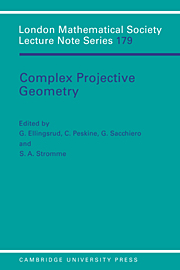Book contents
- Frontmatter
- Contents
- INTRODUCTION
- PROJECTIVE VARIETIES
- VECTOR BUNDLES AND SPECIAL PROJECTIVE EMBEDDINGS
- LIST OF PARTICIPANTS
- Speciality one rational surfaces in P4
- Bounding sections of bundles on curves
- The smooth surfaces of degree 9 in P4
- Compactifying the space of elliptic quartic curves
- Threefolds of degree 11 in P5
- Complete extensions and their map to moduli space
- On the Betti numbers of the moduli space of stable bundles of rank two on a curve
- Gaussian maps for certain families of canonical curves
- Geometry of the Horrocks bundle on P3
- Stability and restrictions of Picard bundles, with an application to the normal bundles of elliptic curves
- Sections planes et majoration du genre des courbes gauches
- A tribute to Corrado Segre
- Un aperçu des travaux mathématiques de G.H. Halphen (1844–1889)
- The source double-point cycle of a finite map of codimension one
- Fibré déterminant et courbes de saut sur les surfaces algébriques
- Courbes minimales dans les classes de biliaison
- Fano 3-folds
- Polarized K3 surfaces of genus 18 and 20
- Protective compactifications of complex afflne varieties
- On generalized Laudal's lemma
- Sur la stabilité des sous-variétés lagrangiennes des variétés symplectiques holomorphes
- Introduction to Gaussian maps on an algebraic curve
- Some examples of obstructed curves in P3
Some examples of obstructed curves in P3
Published online by Cambridge University Press: 06 July 2010
- Frontmatter
- Contents
- INTRODUCTION
- PROJECTIVE VARIETIES
- VECTOR BUNDLES AND SPECIAL PROJECTIVE EMBEDDINGS
- LIST OF PARTICIPANTS
- Speciality one rational surfaces in P4
- Bounding sections of bundles on curves
- The smooth surfaces of degree 9 in P4
- Compactifying the space of elliptic quartic curves
- Threefolds of degree 11 in P5
- Complete extensions and their map to moduli space
- On the Betti numbers of the moduli space of stable bundles of rank two on a curve
- Gaussian maps for certain families of canonical curves
- Geometry of the Horrocks bundle on P3
- Stability and restrictions of Picard bundles, with an application to the normal bundles of elliptic curves
- Sections planes et majoration du genre des courbes gauches
- A tribute to Corrado Segre
- Un aperçu des travaux mathématiques de G.H. Halphen (1844–1889)
- The source double-point cycle of a finite map of codimension one
- Fibré déterminant et courbes de saut sur les surfaces algébriques
- Courbes minimales dans les classes de biliaison
- Fano 3-folds
- Polarized K3 surfaces of genus 18 and 20
- Protective compactifications of complex afflne varieties
- On generalized Laudal's lemma
- Sur la stabilité des sous-variétés lagrangiennes des variétés symplectiques holomorphes
- Introduction to Gaussian maps on an algebraic curve
- Some examples of obstructed curves in P3
Summary
In this paper we compute explicit étale neighborhoods of the points in the Hilbert scheme (the universal family of subschemes of ℙ3) corresponding to curves in ℙ3 of a certain type. Most of these curves are obstructed, that is to say, correspond to singularities of the Hilbert scheme. We have several purposes in doing this. One is simply to add to the list of singularities of the Hilbert scheme for which explicit equations have been computed. This is still a very short list which for the most part consists of fairly simple singularities such as two components crossing transversally ([15] 8.6, [14], [7]) or a double structure on a nonsingular variety ([5]). The example of [15] 8.7 seems to be the only explicit singularity known which is more complicated. Our new examples may clarify some of the causes of obstructions, particularly in terms of the cohomology and syzygies of the homogeneous ideal of the curve. A second purpose of the paper is to investigate a question of Sernesi concerning curves of maximal rank. This will be discussed in a moment. But we also simply wish to give an exposition of the deformation theory in terms of which the computation is made so as to make it more accessible to those who study algebraic space curves. We particularly wish to clarify the relationship between the deformations of a space curve (or subscheme) Y ⊂ X = Proj S, the deformations of the ideal sheaf Jy as a coherent sheaf, and the deformations of the homogeneous ideal I(Y) as a homogeneous S–module.
- Type
- Chapter
- Information
- Complex Projective GeometrySelected Papers, pp. 324 - 340Publisher: Cambridge University PressPrint publication year: 1992
- 3
- Cited by

